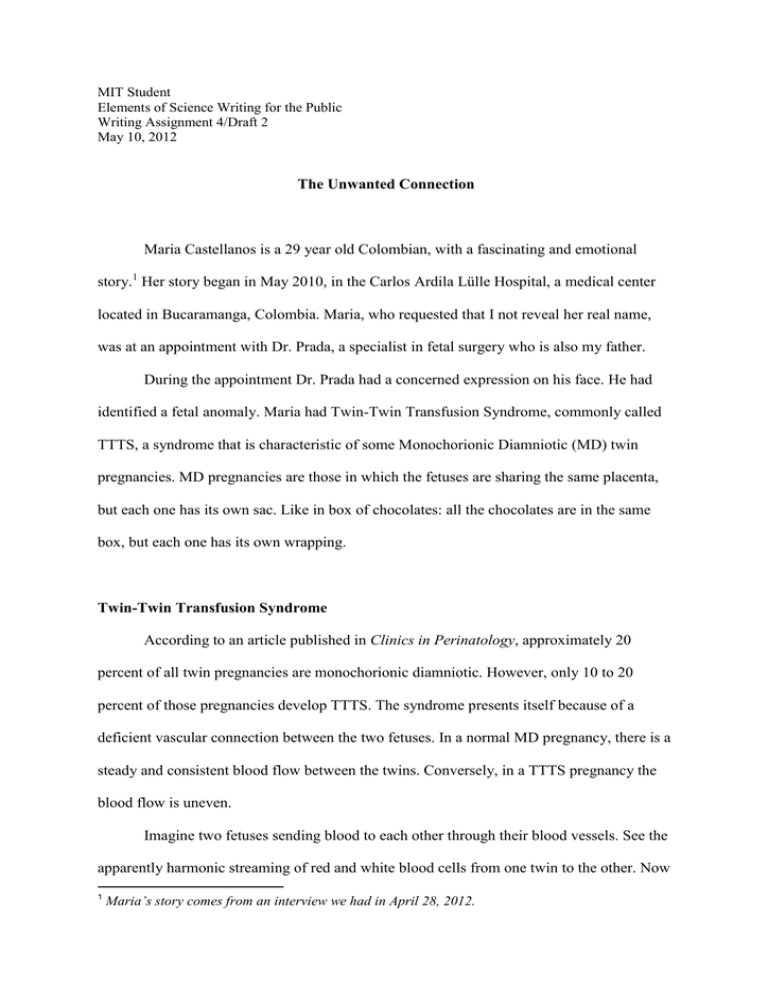Maria Castellanos is a 29 year old Colombian, with a... story. Her story began in May 2010, in the Carlos Ardila...
advertisement

MIT Student Elements of Science Writing for the Public Writing Assignment 4/Draft 2 May 10, 2012 The Unwanted Connection Maria Castellanos is a 29 year old Colombian, with a fascinating and emotional story.1 Her story began in May 2010, in the Carlos Ardila Lülle Hospital, a medical center located in Bucaramanga, Colombia. Maria, who requested that I not reveal her real name, was at an appointment with Dr. Prada, a specialist in fetal surgery who is also my father. During the appointment Dr. Prada had a concerned expression on his face. He had identified a fetal anomaly. Maria had Twin-Twin Transfusion Syndrome, commonly called TTTS, a syndrome that is characteristic of some Monochorionic Diamniotic (MD) twin pregnancies. MD pregnancies are those in which the fetuses are sharing the same placenta, but each one has its own sac. Like in box of chocolates: all the chocolates are in the same box, but each one has its own wrapping. Twin-Twin Transfusion Syndrome According to an article published in Clinics in Perinatology, approximately 20 percent of all twin pregnancies are monochorionic diamniotic. However, only 10 to 20 percent of those pregnancies develop TTTS. The syndrome presents itself because of a deficient vascular connection between the two fetuses. In a normal MD pregnancy, there is a steady and consistent blood flow between the twins. Conversely, in a TTTS pregnancy the blood flow is uneven. Imagine two fetuses sending blood to each other through their blood vessels. See the apparently harmonic streaming of red and white blood cells from one twin to the other. Now 1 Maria’s story comes from an interview we had in April 28, 2012. 2 look closer; notice that not all the blood pumped in one direction is coming back. What is happening? A leakage? Ruben Quintero, a world-renowned fetal surgeon and specialist in maternal medicine, hypothesizes that the heart of one of the fetuses gushes blood at a higher frequency. However, the cause of the deficient connection between the twins is still a scientific enigma. The twin that pumps the blood effectively is called the donor twin and the twin that is not pumping all the blood back to the donor is called the receptor twin. The latter retains the blood that leaves the circulation cycle. Little by little the blood volume accumulates in the receptor twin until the excess becomes noticeable. Studies reported in The Art and Science of Fetal Surgery reveal that no other fetal anomaly causes a greater abdominal expansion than TTTS. While a woman’s abdomen expands between 22 and 24 cm in a normal pregnancy, this anomaly caused Maria’s abdomen to expand 50cm. Consequences When the receptor twin identifies the blood volume excess, its survival instinct comes into play. The fetus starts urinating to reduce the volume of blood inside him. However, this self-defense turns out to be more hazardous than the original problem. Urinating only eliminates the liquid part of the blood. The red and white blood cells, the proteins and the platelets remain in the circulatory system of the fetus, making the receptor’s blood thicker. Think about this fact for a minute. What would you do if your toothpaste suddenly got very thick, and you wanted to take it out from its container? Perhaps press the tube harder? This is precisely what the heart of the receptor twin does to pump the thick blood through his body. Unfortunately, there is a limit. The heart of the donor twin gets fatigued, and the fetus dies of heart failure. 3 On the other side of the placenta is the donor twin. Because of the uneven flow of blood, the blood volume inside this fetus is reduced. As a result, this twin develops anemia and becomes undernourished. Fetuses inside the uterus don’t need to breathe or to digest because the placenta provides everything they need. The lungs and intestines are unnecessary for the fetuses while they are developing. Conversely, the heart, the brain and the suprarenal glands are of great importance. They help the fetuses transport nutrients and respond to stress. For this reason, the donor twin, which barely has the nutrients required to survive, closes the non-essential systems of his body and provides blood only to its heart, brain and suprarenal glands. Survival instinct fails again. The fetus’ self-defense, which closed the non-essential systems, ultimately leads it to its death. Laser Photocoagulation vs. Amnioreduction Maria was filled with grief when my father informed her of the symptoms and repercussions of her disease. She had had a failed pregnancy before, and the idea of losing another pregnancy was devastating. However, her hope reappeared when the doctor explained to her that currently there are two procedures that could save the twins: amnioreduction or laser photocoagulation. Amnioreduction is a procedure that consists of puncturing the abdomen of the pregnant woman to remove the excess of fluid in the sac of the receptor twin. There are two possible complications with this procedure. The first one is that the membranes cannot be punctured indefinitely. After a series of amnioreductions the membranes rupture and the pregnancy ends. The second is that amnioreduction triggers neurologic diseases. The International Amnioreduction Registry tracked a group of 223 women who were treated with amnioreduction, and discovered that out of those infants who survived and underwent 4 cranial ultrasound, 24 percent of recipients and 25 percent of donor twins had abnormal outcomes. According to the Gale Encyclopedia of Medicine, the survival rate using laser photocoagulation is not significantly better than the survival rate using amnioreduction. However, laser photocoagulation reduces the amount of abnormal neurologic outcomes. Studies carried out by Quintero and his research group reveal that 96 percent of the surviving infants who are treated with laser photocoagulation have normal cranial ultrasounds. For this reason, my father recommended to her laser photocoagulation. A technological gem When these statistics are taken into account, it seems reasonable to think that laser photocoagulation is the best solution. But, what is laser photocoagulation? And what makes it different from amnioreduction? The first time I asked my father these two questions I was only ten years old. At the time, I couldn’t fully understand my father’s explanations. Nonetheless, I wanted to comprehend laser photocoagulation. For that reason, my father promised me that one day he would take me to one of those “cool laser surgeries.” Six years later, I was in the operating room. The overall experience was extraordinary. After that day, I started seeing my father’s job from a different perspective. Ruben Quintero says that “laser photocoagulation is the surgery every obstetrician wishes to master.” And I agree with him. The preparation for the procedure begins weeks before the surgery. Each mother’s placenta is unique. Consequently, the doctor needs to perform a series of ultrasounds until he can recreate the 3D placenta in his mind. The ultrasounds are performed two times a week, starting three weeks before the surgery. And a final ultrasound is performed hours prior to the surgery. While the doctor is evaluating the patient for the last time, the operating room is 5 prepared. Part of the preparation involves the set-up of the equipment. The surgery requires two endoscopy towers, an ultrasound, multiple fiber lasers and an anesthesia machine. Depending on the weight and the medical history of the patient, local or regional anesthesia is used. When the patient is under anesthesia, the clock starts ticking. The surgeon has only thirty minutes to cauterize all the deficient blood vessels. If something goes wrong and more time is required, the surgery fails. First, he punctures the abdomen of the patient, making a perforation of only 5 millimeters in diameter. Through the perforation he introduces the endoscopy and the fiber lasers. A screen of twenty-one inches amplifies the image from the endoscope. A web of blood vessels, going from one side of the placenta to the other, is displayed. Using the screen as a guide, the surgeon must identify which are the connections that are causing the uneven blood flow. This task is not easy. My father says it is like “finding needles in a haystack.” When all the unwanted connections have been identified, the cauterization begins. The laser must be directed with great precision. If the surgeon’s hand trembles and the laser makes contact with the blood vessels, disaster ensues. The slightest contact with the laser can make the blood vessels explode. While the surgeon concentrates in this complex task, the assistant nurses are looking at the fetuses in the ultrasound. They must make sure the hearts of the fetuses are functioning normally and verify that there are no threatening bleeds. Finally, the surgeon syphons the excess of fluids in the placenta and removes the endoscope. There is no need for stitches because the puncture is very small. Nevertheless, after the surgery the patient is hospitalized for 24 hours. An extraordinary feature about this surgery is that the patient feels no post-operative pain because a woman’s uterus lacks pain receptors. Another great feature is that following the surgery the patient’s pregnancy proceeds normally. All the pregnancies are Cesarean deliveries, and most of the Cesareans 6 are performed at the 36th week of gestation. Statistics According to the article Complicated Monochorionic Twin Pregnancies published in 2009, TTTS pregnancies that are not treated either with amnioreduction or laser photocoagulation have only a 10 percent survival rate. The article also revealed that in patients treated with laser photocoagulation the survival rate of at least one twin is 79 percent and the survival rate of both twins is 64 percent. Maria belongs to the 79 percent group of women with one survivor twin. Her disease was identified at the 22nd week of gestation, which reduced the success rate of the surgery. Usually patients with TTTS are treated with laser photocoagulation at the 18th week of gestation. Maria’s disease was diagnosed late in the pregnancy because there is only one medical center in Colombia where TTTS can be treated. Among the members of the Latin American Federation of Obstetrics and Gynecology, only three obstetricians are certified to perform laser photocoagulation. In the United States this fetal surgery is more widespread. However, studies directed by the Fetal Care Center of Cincinnati reveal that amnioreduction is still the most commonly used procedure. The acardiac twin One of the advantages of laser photocoagulation is that it can be used to treat most of the possible complications of TTTS. The Art and Science of Fetal Surgery provides information about these complications, such as the complication of Maria’s case. When the anomaly is not identified at an early stage and the blood flow between the fetuses is extremely uneven, the receptor twin doesn’t develop a heart. For this reason, the receptor twin is also called the acardiac twin. In such cases, the donor twin pumps the blood 7 to the acardiac twin, but the latter cannot pump blood back to the donor twin. Again, there are two possible ways to proceed: laser photocoagulation or amnioreduction. However, in the acardiac twin case, laser photocoagulation implies the death of the the fetus that lacks a heart. According to the Institute for Maternal Fetal Health, the acardiac twin cannot survive on its own, and 75 percent of the pregnancies end in an overall loss if the connections between the fetuses are not cauterized. If laser photocoagulation is performed, the acardiac twin is disconnected from all the blood sources. Surprisingly, no additional surgery is performed, and the acardiac twin remains in the placenta during the rest of the pregnancy. This is possible because in MD pregnancies the acardiac twin has its own sac. After the unwanted connections are cauterized the acardiac twin is no longer harmful to the donor twin. At the end of the pregnancy, during the cesarean, the sac with the acardiac twin is withdrawn. For some people, like Maria, choosing laser photocoagulation can be a tough decision, primarily because it involves the termination of the fetus’ life. Laser photocoagulation might give rise to moral debates. Nevertheless, it is one of the technological gems of modernity. It is not only a dazzling procedure, but it has also saved thousands of pregnancies, including Maria’s. Her son is already 16 months old. He is starting to develop his language skills, and until now all his cranial ultrasounds have shown normal outcomes. Laser photocoagulation and Twin-Twin Transfusion Syndrome are terms I have been hearing for years. I know most of the patients with TTTS that my father has treated, and I have been present in five fetal surgeries. Laser photocoagulation has become part of my life. However, this procedure has never ceased to amaze me. Its complexity and its delicacy, as well as its ability to save infants that otherwise would have died, has made me see physicians and surgeons with both awe and admiration. 8 Bibliography Acardiac Twins n.p. The Institute for Maternal Fetal Health. Web. n.d Callen, Peter. Ultrasonography in Obstetrics and Gynecology. Sounders, 2000. Evans, Mark. Adzick, Scott. Holzgreve, Wolfgang. Harrison, Michael. The Unborn Patient. The Art and Science of Fetal Therapy. Soundres, 2001. Gale Encyclopedia of Medicine. Ed. Jacqueline Longe. 3rd ed. 5 vols. Detroit: Gale Group. 2006 Nakayama, Soichiro. Ishii, Keisuke. Hidaka, Nobuhiro. “Perinatal Outcome of Monochorionic Diamniotic Twin Pregnancies.” The Journal of Obstetrics and Gynecology Quintero, Ruben. Diagnostic and Operative Fetoscopy. Informa Healthcare, 2002 Rand, Larry. Lee, Hanmin. “Complicated Monochorionic Twin Pregnancies: Updates in Fetal Diagnosis and Treatment.” Clinics in Perinatology. PubMed 2009, 417-430. Research. PubMed, 2012. Sebire, Neil. Snijders, Rosalinde. Hughes, Karen. Sepulveda, Waldo. “The hidden mortality of monochorionic twin pregnancies.” British Journal of Obstetrics and Gynecology. PubMed. 1997. Senat, Marie-Victoire. Deprest, Jan. Boulvain, Michel. Paupe, Alain. “Endoscopic Laser Surgery versus Serial Amnioreduction for Severe Twin-to-Twin Transfusion Syndrome.” The New England Journal of Medicine. 2004 “Twin Twin Transfusion Syndrome” n.p. Fetal Care Center of Cincinnati.Web. n.d “What is Twin-Twin Transfusion Syndrome?” n.p The TTTS Foundation. Web. n.d MIT OpenCourseWare http://ocw.mit.edu 21W.035 Science Writing and New Media: Elements of Science Writing for the Public Spring 2013 For information about citing these materials or our Terms of Use, visit: http://ocw.mit.edu/terms.





